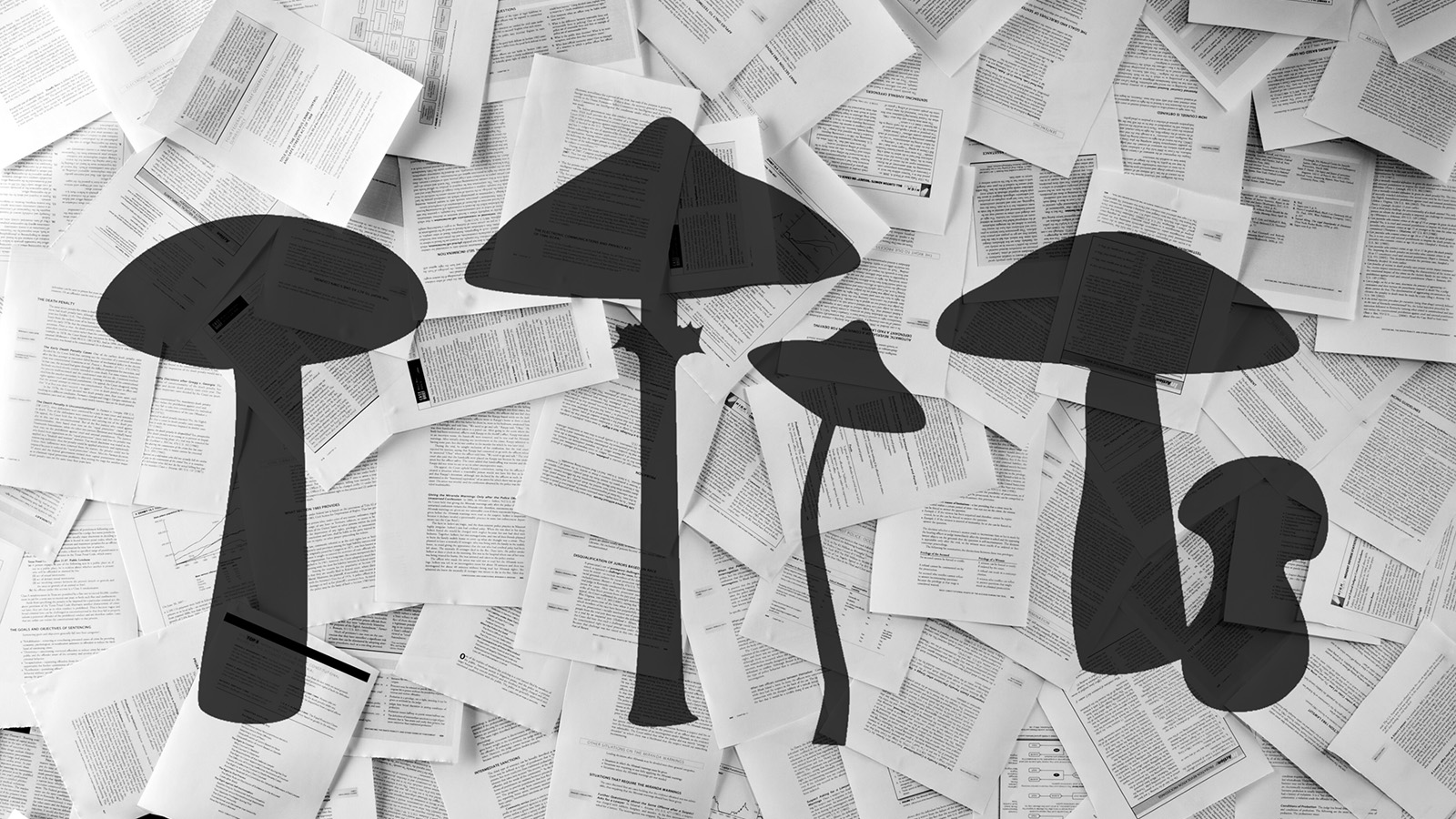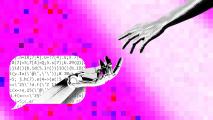They found the letters in the library.
Handwritten letters, dating back to the 19th century, between German researchers and representatives of pharmaceutical firm Parke-Davis. Deeper into the psychedelic archives of the University of Wisconsin, they found a Parke-Davis catalog from the early 1900s — proof that the company had commercialized mescaline, the chemical found in the peyote cactus.
Madison-based lawyer David Casimir had come to the archives because he has a special interest in psychedelic patents — in particular, preventing bad ones from being granted.
There’s a couple ways one can define a “bad patent,” but Casimir’s main concern is patents that are overly broad, giving their owner control over too much. Enough of these overreaching patents (like, say, Apple’s on rectangles with rounded corners) could potentially smother the nascent field of psychedelic treatments.
When a patent application is filed, the hunt begins for evidence that might help patent examiners to better determine if it should be granted.
The publicly accessible information about a subject created before the patent’s filing date — from an easy-to-find online science journal to handwritten letters tucked in a library archive — is supposed to be used to check to see if a patent’s claims are new and non-obvious.
This collection of information, known as “prior art,” acts as a check on granting patents for things that should not be patented — stuff already invented, or obvious applications of things already known.
As psychedelics pass through the looking glass from “field” to “industry,” the role patents will play is hotly contested.
This is a daunting task in almost any field. But psychedelic prior art is uniquely difficult. There are long, dark gaps in research, when the drugs were forbidden and studies suppressed; there is the wealth of anecdotal and recreational experiences recorded and shared informally; and there are vast stores of Indigenous knowledge and practices that may not be well documented.
Casimir has already seen bad psychedelic patents being granted — patents that would’ve never passed if the prior art had actually been checked. Too many bad patents — or even one especially bad patent — could harm the field.
Imagine I get a patent granted for using two slices of bread to hold food. If you wanted to work in the restaurant industry, I could very well make your life an expensive hell.
In an effort to inventory psychedelics’ unusual prior art, Casimir and a team of scientific and legal experts have created an online library of their own, a nonprofit called Porta Sophia — the doorway to wisdom.
And as psychedelics hit an inflection point, passing through the looking glass from “field” to “industry,” having someone watching that doorway has become crucial.
Which Way the COMPASS Points
It was the patent filing that shook the psychedelic plane: COMPASS, a psychedelic mental health company, had filed an international patent around psilocybin (magic mushroom) therapy that claimed… well, a lot.
The claims included basics on what a therapy room looks like and the use of psilocybin to treat many, many mental health disorders. It sparked a millionaire’s row between psychedelic proponent Tim Ferriss and COMPASS investor Christian Angermayer.
Ferriss raised concerns about broad patents hindering research, smothering competition, and limiting accessibility. Angermayer’s response was that patents are the best way to move the field forward by securing investors to develop treatments.
Ferriss versus Angermayer and the COMPASS kerfuffle is merely the most famous flashpoint of a fierce debate dividing the psychedelic community — perhaps the defining schism in the field. And at its heart is a fear of what patents could do.
US 10,596,378
“Patents can unbalance markets, especially at the early stage,” Casimir says. It’s a driving force behind Porta Sophia.
Patents grant companies a limited monopoly on what they contain, providing the financial incentive to invest in research and development, trials, and bringing a psychedelic therapy to the market. To get one, a patent examiner — who is an expert in a related field, e.g., pharmacology — must determine that your patent is new, useful, non-obvious, enabled, and clearly described — i.e., someone who knows the field could make it.
Hit all those marks, and your patent may be granted.
Patents can drive innovation —but a too-broad patent can smother it.
The person or company granted a patent has the legal right to enforce it, which means they can sue anyone who makes, uses, or imports what is covered in the patent. When a patent covers too many things, it becomes a potential bludgeon — creating liability that makes working in the field too risky.
Casimir points to US patent 10,596,378: “Method for treatment of depression using synaptic pathway training,” as an example.
When you get down to it, he argues, the claims are broad and obvious. Essentially, the patent is for using psilocybin, LSD, PCP, ketamine, electro-convulsive therapy, or “cognitive training exercises” to treat depression or “various other neurological conditions.”
“Cognitive training exercise” is a perfect example of mechanistic language used in patents — the patent defines it as “an activity relating to or involving conscious intellectual activity, including but not limited to thinking, reasoning, or remembering.”
So… therapy. Casimir calls it “super ridiculous” in an email.
The patent was granted in March 2020.

Finding the Lost Prior Art
Had the patent examiner who approved US patent 10,596,378 had easy access to reference material on psychedelic prior art, Casimir says, the odds are it would have never been granted.
Patent examiners have limited time and resources when searching for prior art, says Graham Pechenik, a patent lawyer and the founder of Calyx Law, which focuses on IP guidance in the cannabis and psychedelic spaces.
When that prior art may be found in an anthropologist’s journal, Indigenous oral traditions, the vaults of the Erowid website, or a trunk at the University of Wisconsin library, the challenge of locating the prior art is even greater.
The earliest public knowledge on psychedelics comes from Indigenous use, and when the feds criminalized the compounds, much of the prior art shifted into the drug world — an anecdotal experience of using LSD to treat a milk allergy that shows up in a book is prior art. (And, in fact, casts doubt on an already-granted patent around LSD and allergies.)
Porta Sophia’s mission is to gather, document, and index as much of this prior art as possible. The Porta Sophia team scours the world for psychedelic prior art, and has built up a “Rolodex” of archivists, researchers, and enthusiasts that contribute to their efforts. The prior art can then be searched by keyword. Porta Sophia can also send cogent prior art to patent examiners directly.
Public information about a subject created before the patent’s filing date — prior art — is supposed to be used to check to see if a patent should be granted.
Having a searchable database that patent examiners can use helps ensure they have a better understanding of the field and that a claim hits the criteria for being patentable, which should lead to better reviews and better patents being granted.
“Some of this prior art may be out there, but to be able to put it in a centralized repository for a patent examiner to go to and see it all at once means that there’s a much greater likelihood that a patent examiner is going to be able to find what they’re looking for,” Pechenik says.
Also, crucially, people will be able to better challenge bad patents when they are filed.
“It’s very important, this whole repository for prior art,” Rick Doblin, founder and executive director of psychedelic research and education non-profit MAPS and a prominent voice in the field, tells me.
The keys to ensuring patents are granted fairly are well-versed examiners and early challengers who speak up before the patent is granted. If someone spots a problematic patent application — perhaps by using Calyx’s psilocybin patent tracker — they can challenge its being granted.
“As this field is starting — and the land grab, you could say — early [patent] challenges are crucial” to dissuade overbroad patents, Doblin says.
Doblin’s not against patents being granted for patentable things, like novel compounds or original ideas. (Fun fact: MDMA was invented as a patent workaround.)
But patents walk a fine line between encouraging innovation and smothering it, and he does fear the impact of bad patents on getting psychedelic-assisted therapies to the people who need them.
Based on Indigenous knowledge, chased underground, and shared in the shadows, psychedelic prior art is especially hard to find.
The Stakes
“We need psychedelics and psychedelic therapy more than ever before, I would say, in the history of humanity, because of what’s at stake,” Doblin tells me.
What’s at stake are high rates of common mental health disorders like depression, and less common but seriously difficult to treat conditions like PTSD.
But getting psychedelic therapies to patients will cost money. Lots of money.
Patents can be key to getting that investment capital, as well as ensuring the research for it happens in the first place.
Life science investors are attracted to patent portfolios, says Gretchen Temeles, an IP lawyer on the Scientific Advisory Board of Palo Santo Ventures, a psychedelic investment fund.
Here’s Temeles’ “nightmare scenario”: putting millions into a company developing a drug, and “I wake up one morning and discover, after it’s been approved, our competitor is selling it. That’s not a scenario anyone wants to be a part of.”
So investors look for patents — and potential patents — to increase the odds that they get a return on their money.
“It’s kind of like an insurance policy,” says Temeles.
Porta Sophia’s mission is to gather and make accessible psychedelic prior art — to be a “doorway to wisdom” for patent examiners, and ensure bad patents can be challenged.
That reassurance that patents provide about future revenue is one of the primary ways research gets funded, agrees Charles Nichols, professor of pharmacology at LSU Health Sciences Center in New Orleans.
A second-generation psychedelic researcher whose father, David Nichols, is a giant in the field, Nichols says private funding is important in psychedelic research — especially with federal research dollars late to the game, thanks to psychedelics’ status as controlled substances.
Without much government assistance, “you’re seeing a lot of these private entities and companies popping up that are funding research in academia,” Nichols says.
“And to fund that research in academia, a lot of them are relying on the revenues that they are bringing in based on their IP portfolio” — i.e., the patents on the new research they would be granted.
Nichols’ current research into the anti-inflammatory effects of psychedelics is primarily supported by private money.
It’s a structure common to similar fields like the pharmaceutical industry, which is one of investor Christian Angermayer’s points.
But just because something is the way it’s been done in similar fields, that doesn’t mean it’s the way it must be done. Patent “trolling” — accumulating an arsenal of broad patents and making a living by suing other companies rather than making products — is also common in pharmaceuticals, Doblin points out.
“We need psychedelics and psychedelic therapy more than ever before, I would say, in the history of humanity, because of what’s at stake.”
Rick Doblin
The Future of the Field
With a chance to shape the field still possible, as well as Indigenous, cultural, and spiritual import you won’t find in your average orange bottle, the patent conversation in psychedelics can strike a different tone.
These broader, general ethics questions — should these things be patented? — have peculiar salience in the psychedelic space.
But getting the best treatment possible to the most patients possible — optimized compounds, standardized manufacturing processes, passing regulatory approval — it all costs money.
“And that money’s going to have to come from private investors most likely,” Casimir says.
“Good patents play a very important role.”
We’d love to hear from you! If you have a comment about this article or if you have a tip for a future Freethink story, please email us at [email protected].






